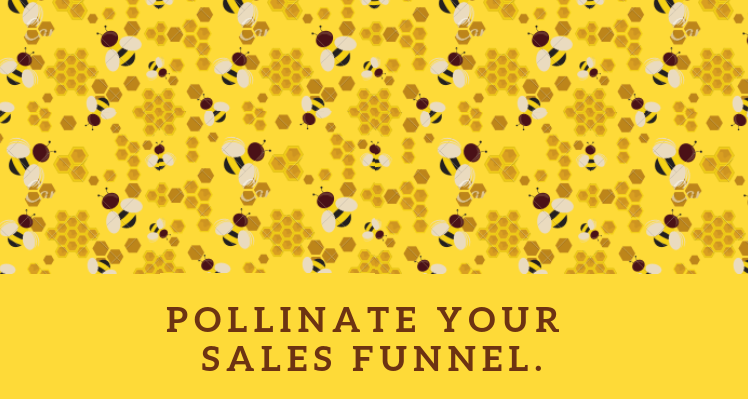
Reading Time: 3 minutes
Why did the bee get married?
Answer: Because he found his honey.
This joke from my son’s animal humor book is the essence of why cross-pollination is one of nature’s most successful symbiotic relationships. It’s a give and take, where both bee and flower win. It has thrived for over 100 million years. Such staying power is worth a deeper dive.
Let’s compare the union between bee and plant to pollinating your business’s sales funnel. Marketing and sales play the honeymaker while the tulip represents your prospect and client.
Generating awareness and interest
Top of the funnel
 When a bee collects pollen and nectar, it transfers microscopic grains from the male part of a flower to the female, enabling fertilization. It works because bees cast a broad yet targeted net, interacting with up to 5,000 flowers a day. Bees strategically seek those plants that can provide what they want (business) and plants benefit (convert) if the need for pollination is met. In marketing, when you approach the groups that don’t value your message and they’ll only see your stinger and rebuff.
When a bee collects pollen and nectar, it transfers microscopic grains from the male part of a flower to the female, enabling fertilization. It works because bees cast a broad yet targeted net, interacting with up to 5,000 flowers a day. Bees strategically seek those plants that can provide what they want (business) and plants benefit (convert) if the need for pollination is met. In marketing, when you approach the groups that don’t value your message and they’ll only see your stinger and rebuff.
Instead:
- define segments to reduce wasting investments.
- craft messages that resonate with your constituents’ needs.
- identify and establish win-win partnerships with key influencers.
- consider direct email, targeted social, and paid search.
 On an individual level, it’s networking with intent. Increase your efficiency and response rate by focusing on the businesses (e.g. industry, size based on revenue) and decision-makers that fit your business model. (Learn more how to reach your top target.)
On an individual level, it’s networking with intent. Increase your efficiency and response rate by focusing on the businesses (e.g. industry, size based on revenue) and decision-makers that fit your business model. (Learn more how to reach your top target.)
Driving engagement and consideration
Middle of the funnel
Pollination works because it’s a series of continuous and strategic touchpoints. Bees’ flight patterns often appear random and inefficient, but their actions are laser sharp. They don’t bother with a plant if there is no prize. While a lilie’s vivid colors and alluring fragrance are the initial hooks, a bee can sense a plant’s electrical charge that emits the availability of nectar.
A prospect often needs to receive an average of seven touches before converting. Your sales and marketing teams are the agents that transmit these crucial signals and listen for a response.
A qualified lead can be identified by those that are receptive.
- Focus your attention on those prospects who have signaled back.
- Assess who interacted with social posts, completed forms, and clicked through newsletters.
- Collect facts to develop a pertinent value proposition.
Now, nurture these relationships.
- Use personalization software (e.g. Hubspot, Marketo, or Salesforce) to automate delivery of tailored content based on preferences that will influence these prospects to move to consideration.
- Provide evaluation experiences through trial offers and demonstrations.
- Offer these through frequent interactions (e.g. face-to-face conversations, phone calls, and online chats).
Validate purchase decision and convert
Bottom of the funnel
By now, you’ve ideally established ample trust so that conversation is less about sales and more about ensuring value. At this stage, the relationship is defined. You bring the pollen and the client provides the nectar. To strengthen your position, be prepared to share testimonials, reviews, and an opportunity to talk with an existing client.
Foster Retention
 If bees only take but do not supply, flowers would not reproduce. The long-term relationship will crumble as there will be no next generation to harvest. In other words, if customer satisfaction is not part of your strategy you may miss out on future business, converting clients to brand champions and their referrals.
If bees only take but do not supply, flowers would not reproduce. The long-term relationship will crumble as there will be no next generation to harvest. In other words, if customer satisfaction is not part of your strategy you may miss out on future business, converting clients to brand champions and their referrals.
According to Harvard Business Review, “acquiring a new customer is anywhere from five to 25 times more expensive than retaining an existing one.” Client nurturing is often neglected when commissions are based only on new sales. If your sales structure is solely acquisition based, move the relationship back to marketing after the deal is closed.
Retention tactics could include:
- leveraging your marketing automation platform or customer relationship management (CRM) to continue distributing useful content.
- communicate results regularly, share successes, and acknowledge how you are fixing shortcomings.
- create additional trust by asking for feedback on how to improve and demonstrate that you’ve listened.
- staff a customer relations team, resources permitting, who can resolve problems, offer incentives, and track customer feedback that informs product enhancements.
Through these stages, you’ve created a mutually beneficial relationship. And, so we come full circle to the nectar collector and the orchid. To sustain and grow a business is an enduring effort. In today’s competitive landscape, you will not survive on a short-term winner-take-all sales approach. Pollinating prospects from awareness through purchase and advocacy is a disciplined multi-stage process. When developing your next strategic plan, remind yourself to act like a bee, and pollinate. And, the union will reward with luscious honey, bountiful crops, and dazzling blossoms.
You might also like my previous post – Chart a course to reach your goals.

